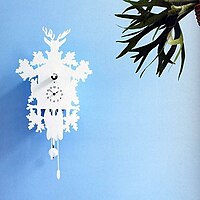Designer
| Occupation | |
|---|---|
Occupation type | Profession |
| Description | |
| Competencies | Technical knowledge, teamwork abilities, artistic skills (varies) |
Fields of employment | see Design professions |

A designer is a person who makes designs for objects. A fashion designer designs clothing, a web designer designs web pages, and an automobile designer designs automobiles. In each case, the designer works with the help of a technician or engineer who understands deeper level concepts of manufacturing and engineering, and the designer themself is largely confined to work at a surface level.
More formally, a designer is an agent that "specifies the structural properties of a design object".[1] In practice, anyone who creates tangible or intangible objects, products, processes, laws, games, graphics, services, and experiences is referred to as a designer.
Overview[edit]
Classically, the main area of design was only architecture, which was understood as the major arts. The design of clothing, furniture, and other common artifacts were left mostly to tradition or artisans specializing in hand making them.
Design is a part of the communication arts, design is something you plan to create, it communicates to the viewer or user a visual and emotional message to change or guide through an emotional connection with a product or service enhancing their experience of the product or brand
With the increasing complexity in industrial design of today’s society, and due to the needs of mass production where more time is usually associated with more cost, the production methods became more complex and with them, the way designs and their production is created. The classical areas are now subdivided into smaller and more specialized domains of design (landscape design, urban design, exterior design, interior design, industrial design, furniture design, cloth design, and much more) according to the product designed or perhaps its means of production. Despite the variety of specializations within the design industry, all of them are very closely connected in terms of the need of professionals having a eye for design and being inspired by each other.
When designers speak of graphic design they speak of it in terms of simplifying complexity so users do not feel overwhelmed when faced with complex systems. More information can lead to a better, simpler solution to whatever problem the designer is trying to solve. Using research methodology to solve problems is one of the most important aspects of design, it enables the designer to properly assess the clients and audience needs. Part of a designer's job is to get to know the audience they intend on canvassing and what will be the placement of any produced material created.
The education, experience, and genetic blocks that form the base of a competent designer is normally similar no matter the area of specialization, only in a later stages of training and work will designer diverge to a specialized field. The methods of teaching or the program and theories followed vary according to schools and field of study. Today, a design team, no matter the scale of the equipment, is usually composed by a master designer (the head of the team) that will have the responsibility to take decisions about the way the creative process should evolve, and a number of technical designers (the hands of the team) specialized in diverse areas according to the product proposed, depending on the type of design industrial design vs graphic design for example. For more complex products, the team will also be composed of professionals from other areas like engineers, advertising specialists, and others as required. The relationships established between team members will vary according to proposed product, the processes of production, the equipment available, or the theories followed during the idea development, but normally they are not too restrictive, giving an opportunity to everyone in the team to take a part in the creation process or at least to express an idea.
Design professions[edit]
Different types of designers include:
- Architecture
- Costume design
- Customer experience design
- Experience design
- Fashion design
- Floral design
- Furniture design
- Game design
- Graphic design
- Industrial design
- Interaction design
- Interior design
- Jewelry design
- Landscape design
- Learning design
- Lighting design
- Packaging design
- Product design
- Scenic design
- Service design
- Software design
- Sound design
- Strategic design
- Textile design
- Urban design
- User experience design (which frequently includes mobile application design)
- User interface design
- Visual design
- Web design
- Yacht design
See also[edit]
Footnotes[edit]
| Wikimedia Commons has media related to Designers. |
Wikidata has the property:
|
| Look up designer in Wiktionary, the free dictionary. |
- ^ Ralph, P. and Wand, Y. (2009). A proposal for a formal definition of the design concept. In Lyytinen, K., Loucopoulos, P., Mylopoulos, J., and Robinson, W., editors, Design Requirements Workshop (LNBIP 14), pp. 103–136. Springer-Verlag, p. 110